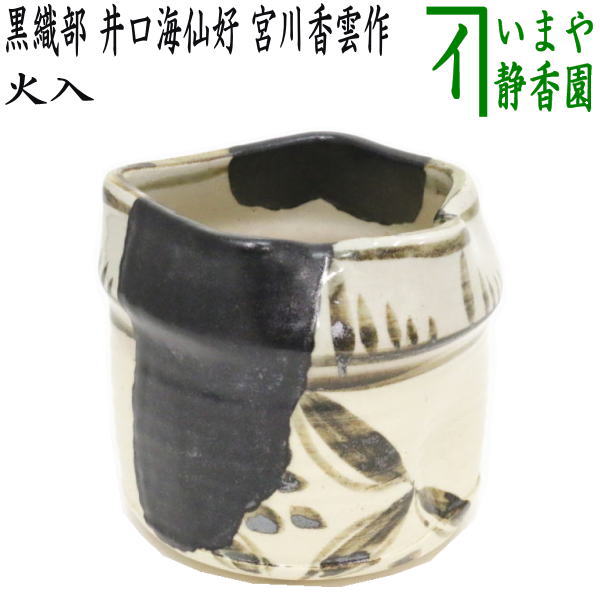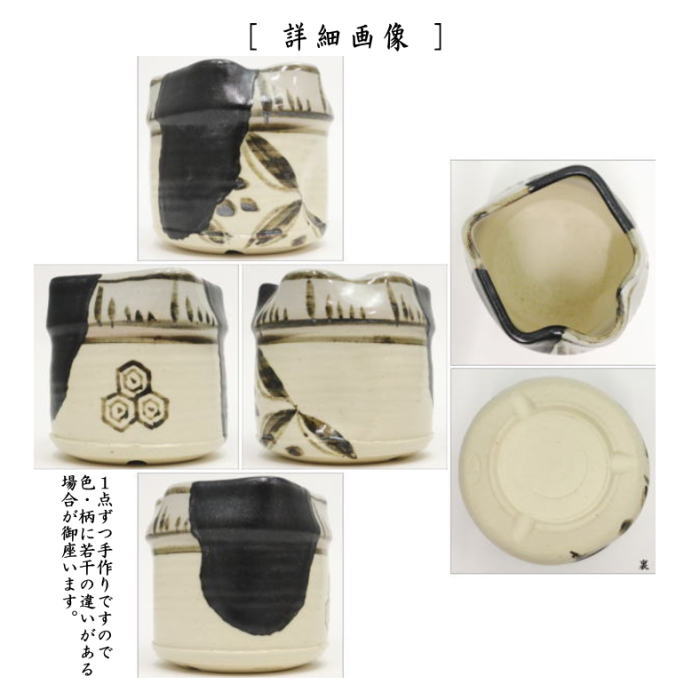1
/
of
2
[Tea utensils/Tea ceremony tools, tobacco tray tools (tobacco tray tools)] Fire bowl, black Oribe, Iguchi Kaisen's favorite, Miyagawa Koun made (Ryukoku Kiln)
[Tea utensils/Tea ceremony tools, tobacco tray tools (tobacco tray tools)] Fire bowl, black Oribe, Iguchi Kaisen's favorite, Miyagawa Koun made (Ryukoku Kiln)
Product Code: tabakobonn-101
Regular price
80,850 円
Regular price
Sale price
80,850 円
Unit price
/
per
Tax included.
Shipping calculated at checkout.
Couldn't load pickup availability
●Hiire is a container that is placed inside the tobacco tray and holds fire for lighting tobacco.
Put ashes inside and bury some hot charcoal in the center to use as a starting point for smoking.
To bury the cut charcoal, first put a charcoal fire into the ashes in the fire bowl to warm the ashes, then remove the charcoal and smooth the ashes with the fire tongs. Then light a piece of charcoal in the center, leaving the black part intact so that the top does not burn and turn to ash when a guest smokes. Place the charcoal with the hot side down and the black side up, and bury it at a slight angle when viewed from the front so that the top sticks out slightly so that it is easier to smoke with a pipe. Press the ash down with the ash press and make a line with the fire tongs.
The charcoal is tilted to the right in the Omotesenke and Mushakojisenke schools, and to the left in the Urasenke school.
Ashigata pots with radial lines are often used, but there are also variations depending on the style and firing method.
It seems that they originally began as small incense burners or to serve as side dishes, and the combination of tobacco tray and fire box takes into consideration the material, shape, and size relative to the tobacco tray, the height of the rim of the tobacco tray and the height of the fire box, the glaze color of the fire box and the paint color of the tobacco tray, etc.
Copper and ironware are not usually used, and ceramics are mainly used, but porcelain such as blue and white and gosu are paired with shin-nuri or tamari-nuri finishes, glazed pottery such as Shino, Oribe, and Karatsu are paired with ikkan-bari, and natural glazed pottery such as Bizen and Shigaraki are paired with wood or burnt cedar.
Size: Approx. diameter 10.6 x height 9.2 cm
Author: Koun Miyagawa (Ryuukokugama)
----------
[2nd Generation Miyagawa Koun]
Born in Kyoto Prefecture in 1938
1980: Name succession
The second generation Koun was the nephew of Shinkatsu Kosai and studied under the sixth generation Shimizu Rokubei.
Belonged to the Ceramic Artists Club, but left in 1968 to pursue his own path
1982: Name succession exhibition at Takashimaya in Kyoto
Tetsuji Miyagawa is currently creating a work as a next-generation artist.
----------
Box: Wooden box
Put ashes inside and bury some hot charcoal in the center to use as a starting point for smoking.
To bury the cut charcoal, first put a charcoal fire into the ashes in the fire bowl to warm the ashes, then remove the charcoal and smooth the ashes with the fire tongs. Then light a piece of charcoal in the center, leaving the black part intact so that the top does not burn and turn to ash when a guest smokes. Place the charcoal with the hot side down and the black side up, and bury it at a slight angle when viewed from the front so that the top sticks out slightly so that it is easier to smoke with a pipe. Press the ash down with the ash press and make a line with the fire tongs.
The charcoal is tilted to the right in the Omotesenke and Mushakojisenke schools, and to the left in the Urasenke school.
Ashigata pots with radial lines are often used, but there are also variations depending on the style and firing method.
It seems that they originally began as small incense burners or to serve as side dishes, and the combination of tobacco tray and fire box takes into consideration the material, shape, and size relative to the tobacco tray, the height of the rim of the tobacco tray and the height of the fire box, the glaze color of the fire box and the paint color of the tobacco tray, etc.
Copper and ironware are not usually used, and ceramics are mainly used, but porcelain such as blue and white and gosu are paired with shin-nuri or tamari-nuri finishes, glazed pottery such as Shino, Oribe, and Karatsu are paired with ikkan-bari, and natural glazed pottery such as Bizen and Shigaraki are paired with wood or burnt cedar.
Size: Approx. diameter 10.6 x height 9.2 cm
Author: Koun Miyagawa (Ryuukokugama)
----------
[2nd Generation Miyagawa Koun]
Born in Kyoto Prefecture in 1938
1980: Name succession
The second generation Koun was the nephew of Shinkatsu Kosai and studied under the sixth generation Shimizu Rokubei.
Belonged to the Ceramic Artists Club, but left in 1968 to pursue his own path
1982: Name succession exhibition at Takashimaya in Kyoto
Tetsuji Miyagawa is currently creating a work as a next-generation artist.
----------
Box: Wooden box
[About paid individual packaging]
If you would like individual packaging (charges apply), click View Cart, check "I would like individual packaging", and then add the desired quantity to "Quantity".
*The following products are not eligible for individual packaging. If you would like to package the folding fan or colored paper, we will provide a paid box or bag for each.
- Mail delivery products
- Folding fan (paid box available/no packaging)
- Colored paper (paid bag available/no packaging)
- Zodiac theme related products
【Related Category】
Share
![[Tea utensils/Tea ceremony tools, tobacco tray tools (tobacco tray tools)] Fire bowl, black Oribe, Iguchi Kaisen's favorite, Miyagawa Koun made (Ryukoku Kiln)](http://imaya.co.jp/cdn/shop/products/tabakobonn-101_4.jpg?v=1709095093&width=1445)
![[Tea utensils/Tea ceremony tools, tobacco tray tools (tobacco tray tools)] Fire bowl, black Oribe, Iguchi Kaisen's favorite, Miyagawa Koun made (Ryukoku Kiln)](http://imaya.co.jp/cdn/shop/products/tabakobonn-101_5.jpg?v=1709095093&width=1445)






















